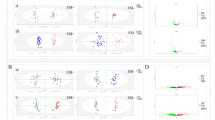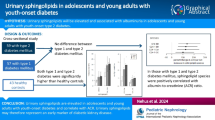Abstract
Plasma deoxy-sphingoid bases are elevated in type 2 diabetes patients and correlate with the stage of diabetic distal sensorimotor polyneuropathy; however, associations between deoxy-sphingolipids (DSL) and neuropathy in type 1 diabetes have not been examined. The primary aim of this exploratory pilot study was to assess the associations between multiple sphingolipid species including DSL and free amino acids and the presence of symptomatic neuropathy in a DCCT/EDIC type 1 diabetes subcohort. Using mass spectroscopy, plasma levels of DSL and free amino acids in DCCT/EDIC type 1 diabetes participants (n = 80), with and without symptoms of neuropathy, were investigated. Patient-determined neuropathy was based on 15-item self-administered questionnaire (Michigan Neuropathy Screening Instrument) developed to assess distal symmetrical peripheral neuropathy in diabetes. Patients who scored ≥4, or reported inability to sense their feet during walking or to distinguish hot from cold water while bathing were considered neuropathic. Plasma levels of ceramide, sphingomyelin, hexosyl- and lactosylceramide species, and amino acids were measured and analyzed relative to neuropathy status in the patient. Deoxy-C24-ceramide, C24- and C26-ceramide were higher in patients with neuropathy than those without neuropathy. Cysteine was higher in patients with neuropathy. No differences in other sphingolipids or amino acids were detected. The covariate-adjusted Odds Ratios of positive patient-reported neuropathy was associated with increased levels of deoxy-C24-, and deoxy-C24:1-ceramide; C22-, C24-, and C26-ceramide; and cysteine. Plasma deoxy-ceramide and ceramide species may have potential diagnostic and prognostic significance in diabetic neuropathy.




Similar content being viewed by others
Abbreviations
- HSAN1:
-
Hereditary sensory and autonomic neuropathy type 1
- DSL:
-
Deoxy-sphingolipids
- SPT:
-
Serine palmitolytransferase
- DCCT:
-
The Diabetes Control and Complications Trial
- EDIC:
-
Epidemiology of Diabetes Interventions
- AER:
-
Albumin excretion rate
- MNSI:
-
Michigan Neuropathy Screening Instrument
- HPLC-ESI-MS/MS:
-
High-performance liquid chromatography-tandem mass spectrometry
References
Baird, R. D., Kitzen, J., Clarke, P. A., Planting, A., Reade, S., Reid, A., et al. (2009). Phase I safety, pharmacokinetic, and pharmacogenomic trial of ES-285, a novel marine cytotoxic agent, administered to adult patients with advanced solid tumors. Molecular Cancer Therapeutics, 8, 1430–1437.
Bejaoui, K., Wu, C., Scheffler, M. D., Haan, G., Ashby, P., Wu, L., et al. (2001). SPTLC1 is mutated in hereditary sensory neuropathy, type 1. Nature Genetics, 27, 261–262.
Bertea, M., Rütti, M. F., Othman, A., Marti-Jaun, J., Hersberger, M., von Eckardstein, A., & Hornemann, T. (2010). Deoxysphingoid bases as plasma markers in diabetes mellitus. Lipids in Health and Disease, 9, 84.
Bielawski, J., Pierce, J. S., Snider, J., Rembiesa, B., Szulc, Z. M., & Bielawska, A. (2009). Comprehensive quantitative analysis of bioactive sphingolipids by high-performance liquid chromatography-tandem mass spectrometry. Methods in Molecular Biology, 579, 443–467.
Dawkins, J. L., Hulme, D. J., Brahmbhatt, S. B., Auer-Grumbach, M., & Nicholson, G. A. (2001). Mutations in SPTLC1, encoding serine palmitoyltransferase, long chain base subunit-1, cause hereditary sensory neuropathy type I. Nature Genetics, 27, 309–312.
Diabetes Control and Complications Trial Research Group. (1993). The effect of intensive treatment of diabetes on the development and progression of long-term complications in insulin-dependent diabetes mellitus. New England Journal of Medicine, 329, 977–986.
Dohrn, M. F., Othman, A., Hirshman, S. K., Bode, H., Alecu, I., Fähndrich, E., et al. (2015). Elevation of plasma 1-deoxy-sphingolipids in type 2 diabetes mellitus: A susceptibility to neuropathy? European Journal of Neurology, 22, 806–814.
Duan, J., & Merrill, A. H, Jr. (2015). 1-Deoxysphingolipids encountered exogenously and made de novo: Dangerous mysteries inside an enigma. Journal of Biological Chemistry, 290, 15380–15389.
Dyck, P. J., Karnes, J., O’Brien, P. C., & Swanson, C. J. (1986). Neuropathy Symptom Profile in health, motor neuron disease, diabetic neuropathy, and amyloidosis. Neurology, 36, 1300–1308.
Epidemiology of Diabetes Interventions and Complication (EDIC) Research Group. (1999). Epidemiology of Diabetes Interventions and Complications (EDIC). Design, implementation, and preliminary results of a long-term follow-up of the Diabetes Control and Complications Trial cohort. Diabetes Care, 22, 99–111.
Feldman, E. L., Stevens, M. J., Thomas, P. K., Brown, M. B., Canal, N., & Greene, D. A. (1994). A practical two-step quantitative clinical and electrophysiological assessment for the diagnosis and staging of diabetic neuropathy. Diabetes Care, 17, 1281–1289.
Fox, T. E., & Kester, M. (2010). Therapeutic strategies for diabetes and complications: A role for sphingolipids? Advances in Experimental Medicine and Biology, 688, 206–216.
Galadari, S., Rahman, A., Pallichankandy, S., Galadari, A., & Thayyullathil, F. (2013). Role of ceramide in diabetes mellitus: Evidence and mechanisms. Lipids in Health and Disease, 12, 98.
Garofalo, K., Penno, A., Schmidt, B. P., Lee, H. J., Frosch, M. P., & von Eckardstein, A. (2011). Oral l-serine supplementation reduces production of neurotoxic deoxysphingolipids in mice and humans with hereditary sensory autonomic neuropathy type 1. Journal of Clinical Investigation, 121, 4735–4745.
Grösch, S., Schiffmann, S., & Geisslinger, G. (2012). Chain length-specific properties of ceramides. Progress in Lipid Research, 51, 50–62.
Hammad, S. M., Pierce, J. S., Soodavar, F., Smith, K. J., Al Gadban, M. M., Rembiesa, B., et al. (2010). Blood sphingolipidomics in healthy humans: Impact of sample collection methodology. Journal of Lipid Research, 51, 3074–3087.
Hannun, Y. A., & Obeid, L. M. (2008). Principles of bioactive lipid signalling: Lessons from sphingolipids. Nature Review Molecular Cell Biology, 9, 139–150.
Hartmann, D., Wegner, M. S., Wanger, R. A., Ferreirós, N., Schreiber, Y., Lucks, J., et al. (2013). The equilibrium between long and very long chain ceramides is important for the fate of the cell and can be influenced by co-expression of CerS. International Journal of Biochemistry & Cell Biology, 45, 1195–1203.
Herman, W. H., Pop-Busui, R., Braffett, B. H., Martin, C. L., Cleary, P. A., Albers, J. W., et al. (2012). Use of the Michigan Neuropathy Screening Instrument as a measure of distal symmetrical peripheral neuropathy in Type 1 diabetes: Results from the Diabetes Control and Complications Trial/Epidemiology of Diabetes Interventions and Complications. Diabetic Medicine, 29, 937–944.
Klein, R. L., Hammad, S. M., Baker, N. L., Hunt, K. J., Al Gadban, M. M., Cleary, P. A., et al. (2014). Decreased plasma levels of select very long chain ceramide species are associated with the development of nephropathy in type 1 diabetes. Metabolism, 63, 1287–1295.
Kramer, R., Bielawski, J., Kistner-Griffin, E., Othman, A., Alecu, I., Ernst, D., et al. (2015). Neurotoxic 1-deoxysphingolipids and paclitaxel-induced peripheral neuropathy. FASEB Journal, 29, 4461–4472.
Massard, C., Salazar, R., Armand, J. P., Majem, M., Deutsch, E., García, M., et al. (2012). Phase I dose-escalating study of ES-285 given as a three-hour intravenous infusion every three weeks in patients with advanced malignant solid tumors. Investigational New Drugs, 30, 2318–2326.
Othman, A., Bianchi, R., Alecu, I., Wei, Y., Porretta-Serapiglia, C., Lombardi, R., et al. (2015). Lowering plasma 1-deoxysphingolipids improves neuropathy in diabetic rats. Diabetes, 64, 1035–1045.
Othman, A., Rütti, M. F., Ernst, D., Saely, C. H., Rein, P., Drexel, H., et al. (2012). Plasma deoxysphingolipids: A novel class of biomarkers for the metabolic syndrome? Diabetologia, 55, 421–431.
Park, J. W., Park, W. J., Kuperman, Y., Boura-Halfon, S., Pewzner-Jung, Y., & Futerman, A. H. (2013). Ablation of very long acyl chain sphingolipids causes hepatic insulin resistance in mice due to altered detergent-resistant membranes. Hepatology, 57, 525–532.
Penno, A., Reilly, M. M., Houlden, H., Laurá, M., Rentsch, K., Niederkofler, V., et al. (2010). Hereditary sensory neuropathy type 1 is caused by the accumulation of two neurotoxic sphingolipids. Journal of Biological Chemistry, 285, 11178–11187.
Pinto, S. N., Silva, L. C., Futerman, A. H., & Prieto, M. (2011). Effect of ceramide structure on membrane biophysical properties: The role of acyl chain length and unsaturation. Biochimica Biophysica Acta, 1808, 2753–2760.
Rotthier, A., Auer-Grumbach, M., Janssens, K., Baets, J., Penno, A., Almeida-Souza, L., et al. (2010). Mutations in the SPTLC2 subunit of serine palmitoyltransferase cause hereditary sensory and autonomic neuropathy type I. American Journal of Human Genetics, 87, 513–522.
Schöffski, P., Dumez, H., Ruijter, R., Miguel-Lillo, B., Soto-Matos, A., Alfaro, V., & Giaccone, G. (2011). Spisulosine (ES-285) given as a weekly three-hour intravenous infusion: Results of a phase I dose-escalating study in patients with advanced solid malignancies. Cancer Chemotherapy and Pharmacology, 68, 1397–1403.
Silva, L. C., Ben David, O., Pewzner-Jung, Y., Laviad, E. L., Stiban, J., Bandyopadhyay, S., et al. (2012). Ablation of ceramide synthase 2 strongly affects biophysical properties of membranes. Journal of Lipid Research, 53, 430–436.
Wei, N., Pan, J., Pop-Busui, R., Othman, A., Alecu, I., Hornemann, T., & Eichler, F. S. (2014). Altered sphingoid base profiles in type 1 compared to type 2 diabetes. Lipids in Health and Disease, 13, 161.
Zhang, Y., Li, X., Becker, K. A., & Gulbins, E. (2009). Ceramide-enriched membrane domains-structure and function. Biochimca Biophysica Acta, 1788, 178–183.
Zheng, W., Kollmeyer, J., Symolon, H., Momin, A., Munter, E., Wang, E., et al. (2006). Ceramides and other bioactive sphingolipid backbones in health and disease: Lipidomic analysis, metabolism and roles in membrane structure, dynamics, signaling and autophagy. Biochimica Biophysica Acta, 1758, 1864–1884.
Acknowledgments
The technical assistance of Ms. Charlyne Chassereau and Ms. Andrea Semler is acknowledged. The authors are grateful to the patients in the DCCT/EDIC for their long-term participation in this important trial.
Funding
Financial support for this work was provided by the NIDDK Diabetic Complications Consortium (DiaComp, www.diacomp.org), Grant DK076169 (RLK). This work was also supported by the National Institutes of Health Grant P01-HL55782 (MLV). Additional funding was obtained from the Department of Veterans Affairs Merit Review Program (MLV and RLK). The contents of this manuscript do not represent the views of the Department of Veterans Affairs or the United States Government. Sphingolipid analyses were supported in part by the Lipidomics Shared Resource, Hollings Cancer Center (P30 CA138313), and the Lipidomics Core in the SC Lipidomics and Pathobiology COBRE, Department Biochemistry (P20 RR017677), MUSC. The DCCT/EDIC is sponsored through research contracts from the National Institute of Diabetes, Endocrinology and Metabolic Diseases of the National Institute of Diabetes and Digestive and Kidney diseases (NIDDK) and the National Institutes of Health. Additional support was provided by the National Center for Research Resources through the GCRC program and by Genentech, Inc. through a cooperative research and development agreement with the NIDDK.
Author Contributions
SMH and RLK directed sample analyses and analyzed the data. SMH and RLK wrote the manuscript, and NLB conducted the statistical analyses of the data and wrote the relevant sections. JMELA contributed to data analysis and presentation. SDS, JSP and JB developed the methodology for the deoxy-sphingolipid analysis and generated the sphingolipid data using mass spectroscopy. MFL-V guided patient selection, contributed to the discussion and reviewed/edited the manuscript. SMH and RLK are the guarantors of this work and, as such, had full access to all the data in the study and took the responsibility for the integrity of the data and the accuracy of the data analysis.
Author information
Authors and Affiliations
Consortia
Corresponding author
Ethics declarations
Conflicts of interest
The authors declare that they have no conflict of interest.
Ethical Approval
The Institutional Review Board (IRB) at the Medical University of South Carolina (MUSC) and all participating DCCT/EDIC centers approved the sample collection procedures. Written informed consent was obtained from all participants.
Rights and permissions
About this article
Cite this article
Hammad, S.M., Baker, N.L., El Abiad, J.M. et al. Increased Plasma Levels of Select Deoxy-ceramide and Ceramide Species are Associated with Increased Odds of Diabetic Neuropathy in Type 1 Diabetes: A Pilot Study. Neuromol Med 19, 46–56 (2017). https://doi.org/10.1007/s12017-016-8423-9
Received:
Accepted:
Published:
Issue Date:
DOI: https://doi.org/10.1007/s12017-016-8423-9




